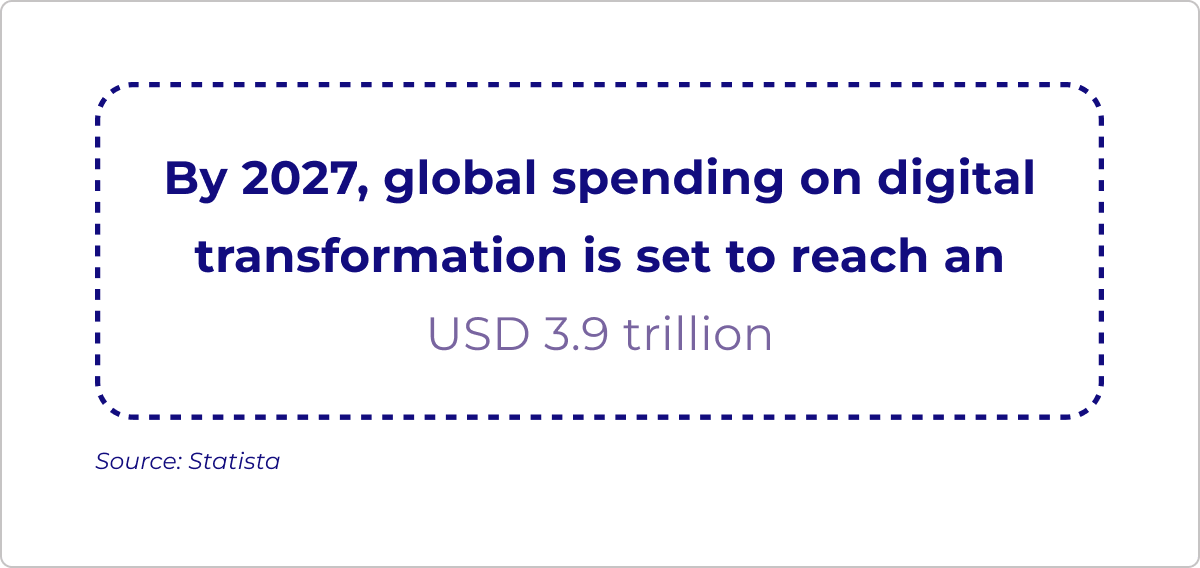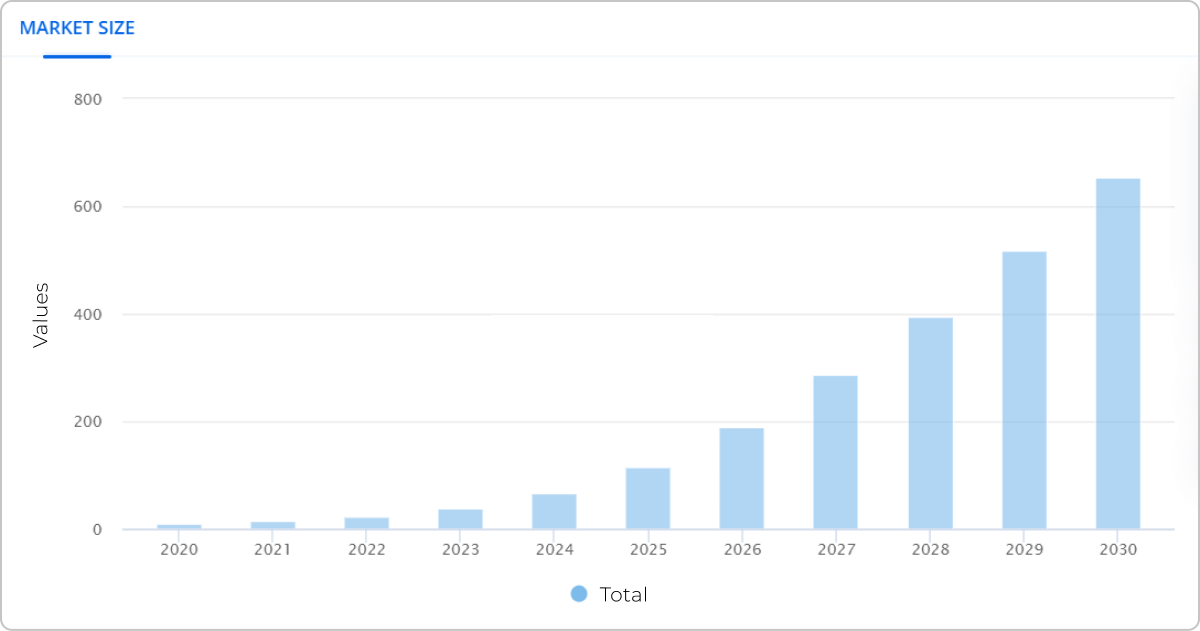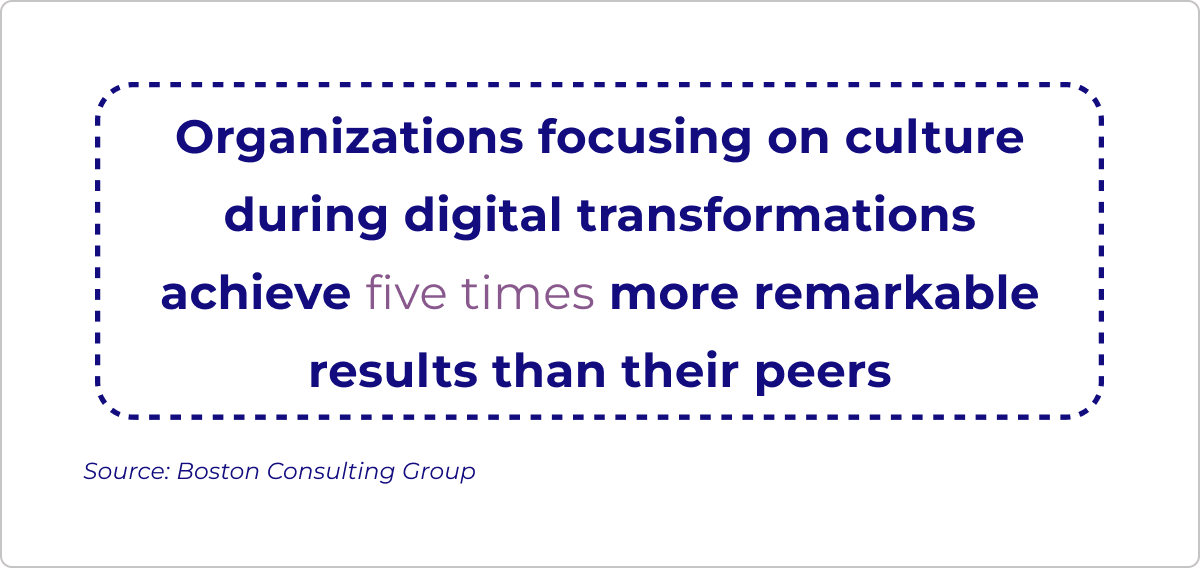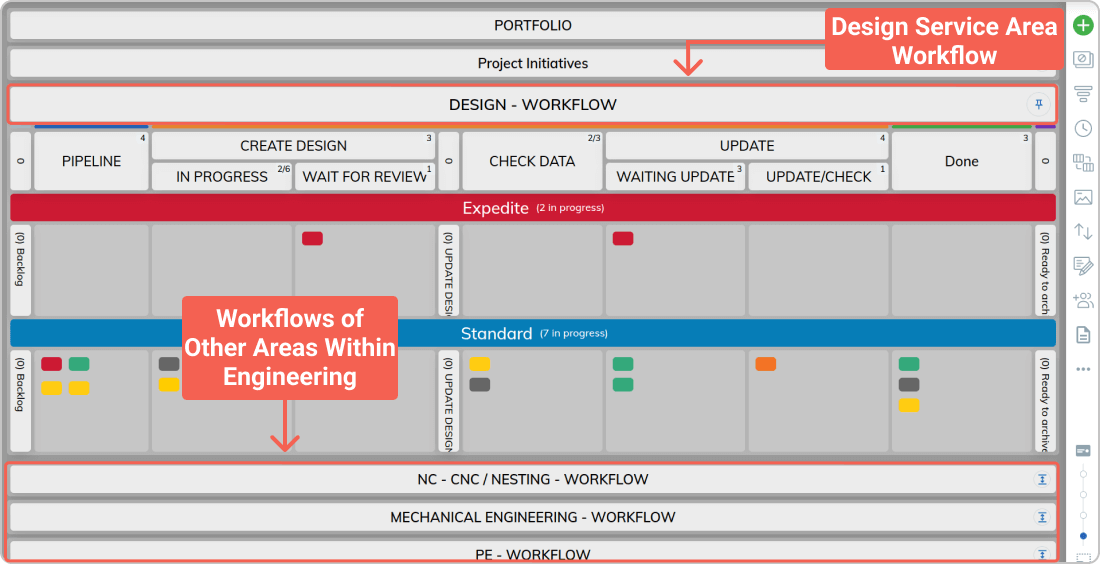Think of digital transformation as the industrial revolution of our time. Just as steam engines once powered incredible change, today's digital tools are revolutionizing businesses everywhere. Since the COVID-19 pandemic, the term digital transformation has rocketed in popularity. Whether you're leveraging cloud technology, harnessing the power of GenAI, or adopting remote work as the new normal, it's clear: companies that don't embrace this change are risking obsolescence.
Let's dive into the exciting world of digital transformation. We'll explore:
- Global investments in digital transformation initiatives
- Key drivers behind the shift to digital
- Core capabilities that define a digital enterprise
- Common pitfalls and why some transformations fail
Join us as we uncover the data and insights driving this transformative wave!
 Worldwide popularity trend of the topic" Digital transformation" over time (Google Trends)
Worldwide popularity trend of the topic" Digital transformation" over time (Google Trends)
When Did Digital Transformation Buzz Emerge?
First, let's clear up any confusion: digital transformation isn't exactly new. In fact, it's been evolving for quite some time. Respected research shows a surge in papers on this topic starting around 2014. Key terms like "digital transformation," "digitalization," and "management" frequently appear, often referring to changes in services, processes, organizational structures, and even in business communication. This underscores the critical need for effective governance methods to manage these transformations, highlighting the connection between management and digital initiatives.
How Much Do We Invest in Becoming Digital?
Are you curious about the investments driving our digital future? Let's dive into the numbers and see how much is being spent on digital initiatives.
1. By 2027, global spending on digital transformation is set to reach an astonishing USD 3.9 trillion.
Statista: Spending on Digital Transformation Worldwide from 2017 to 2027

2. The global digital transformation market is set to skyrocket with an impressive compound annual growth rate (CAGR) of 23.6% from 2022 to 2030.
The digital transformation market is experiencing explosive growth, with global spending projected to soar from USD 588 billion in 2021 to a staggering USD 3.9 trillion by 2027. This impressive trajectory highlights the immense investment and rapid evolution in digital initiatives worldwide.
For example, based on statista.com, ad spending in the digital Out-of-Home Advertising market worldwide is forecasted to reach US$19.08 billion in 2025, signaling continued growth in digital channels beyond traditional online platforms. A 2025 survey found that over three-quarters of senior executives in advertising see generative AI positively impacting agencies, with AI now helping create text, images, videos, and strategies. Beyond that, businesses are producing engaging and authentic AI-generated content with Grammarly, QuillBot, and with Humanize AI.
Polaris Market Research: Digital Transformation Market Share, Size, Trends
3. Digital transformation specialist is one of the jobs with the largest growth over the last 5 years.
These roles are crucial for business transformation across various industries, including employment services, financial services, capital markets, media, entertainment, sports, research, design, and business management services. The future looks promising, with a forecasted growth of approximately 4 million digitally enabled positions, including e-commerce specialists, digital transformation specialists, and digital marketing and strategy specialists.
World Economic Forum: Future of Jobs Report 2023
The AI Disruptive Role in Digital Transformation
Embracing generative AI is becoming crucial for businesses aiming to stay competitive and innovative in a rapidly evolving landscape.
4. Scaling Gen AI is the top priority for CEOs in 2024.
Since the pandemic, digital transformation has become a top priority for executives, revolutionizing work methods, technologies, and remote work setups. However, nothing has made waves quite like Gen AI. The pressing question now is how to scale this groundbreaking innovation to transform businesses and reshape entire industries.
McKinsey&Company: Eight CEO Priorities for 2024
5. 34% of CEOs have identified AI as the next big theme in business transformation following the digital revolution.
Gartner: CEO Survey
6. The Generative AI market in North America will reach a market volume of USD 130.70 billion by 2030.
This explosive growth isn't limited to North America. The Asia/Pacific region is also experiencing a significant surge in GenAI adoption, with projected spending expected to hit USD 26 billion by 2027. Globally, the Gen AI market is on a robust upward trajectory, demonstrating a forecasted compound annual growth rate (CAGR) of over 24.4% from 2023 to 2030.
Statista: Generative AI - North America
 GenAI market size in North America
GenAI market size in North America
7. In 2023, only about a third of global organizations had adopted Generative AI, with North America leading at 40% adoption.
Generative AI is at the forefront of digital transformation initiatives, yet many organizations worldwide have not yet implemented any technology.
Statista: Digital Transformation Stats and Facts
8. In 2023, AI skills in India were 2.75 times more prevalent than the global average.
India's strong adoption of AI skills cements its position as a global leader in AI expertise, followed by the USA and Germany. In contrast, the UAE, Switzerland, and Italy have shown the lowest relative AI skill penetration rates from 2015 to 2023.
Statista: Relative Penetration Rate of AI Skills
What Are the Key Capabilities of a Digital Enterprise?
To thrive in the digital age, enterprises need a laser-focused strategy for delivering value. Let's explore the rest of the essential capabilities that define a successful digital enterprise.
9. Successful transformations require a crystal-clear strategy focused on business value and a team of top talent.
To drive transformative impact, McKinsey's analysis of 200 large-scale digital and AI transformations highlights these critical elements: a crystal-clear strategy focused on business value, a team of top talent, a scalable operating model, seamless data access, and exceptional adoption and change management.
Rewired: The McKinsey Guide to Outcompeting in the Age of Digital and AI
10. Prioritizing culture in digital transformation leads to results five times more remarkable than other approaches.
A study by Boston Consulting, a global leader in business strategy, revealed that organizations focusing on cultural transformation achieved five times more remarkable results than their peers. The research offers a strategic plan to shift to digital culture: start by articulating the change, crystallizing how to make it a reality by activating essential leadership traits and employee engagement, and finding ways to reinforce new organizational behaviors.
Boston Consulting Group: It's not a DX without a Digital Culture

What Are the Drivers of Digital Transformation?
Agile transformation, gaining a competitive edge, remote work, and evolving user behavior are the key factors driving digital enterprise transformations.
11. 34% of organizations have identified Agile adoption as a crucial driver for supporting digital transformation initiatives.
This trend is even more pronounced among medium and large companies, which are significantly more likely to leverage Agile methodologies to propel their digital transformation efforts. Embracing Agile is becoming essential for businesses aiming to thrive in a fast-evolving digital landscape.
12. 70% of executives from large biopharma companies view digital innovation as a critical competitive differentiator.
With 82% of respondents agreeing that adopting a digital operating model will continue to rise post-pandemic, it's clear that digital transformation is essential for maintaining a competitive edge in the biopharma industry.
Deloitte: Biopharma digital transformation
13. The rise of remote work has been a powerful driver of digital transformation, with over 90% of organizations worldwide implementing cloud technologies by 2023.
This widespread adoption of cloud technologies underscores the critical role of remote work in accelerating digital transformation. As remote work continues to shape the future of business, leveraging cloud solutions becomes essential for successful organizations aiming to stay agile and competitive.
Statista: Digital Transformation Stats and Facts
14. 60% of Gen Z prefer to solve their problems using self-service options.
This trend highlights the growing demand for exceptional customer support and intuitive self-service solutions. Businesses must prioritize digital support tools and platforms that empower users to find answers independently, meeting the expectations of a new generation and staying ahead of the competition.
Hubspot: Why Gen Z Demands Exceptional Customer Support
15. Omnichannel shoppers, 77.4% of consumers, spend 15-30% more than single-channel shoppers.
Indeed, shifts in user behavior have navigated digital transformation to reimagine the shopping experience in just a decade. Omnichannel shoppers' influence extends beyond transactions, boosting brand perception and loyalty. Retailers adapting to this behavior can significantly increase customer loyalty and spending.
IDC: Retail Reinvention in the AI Era
How Much Does Digital Transformation Fail?
Unfortunately, many organizations, such as the once-iconic Blockbuster, have failed to adapt, leading to their downfall. The inability to swiftly develop and implement new digital business models has proven disastrous for some companies.
16. A staggering 87.5% of digital transformation attempts fail.
This high digital transformation failure rate underscores organizations' immense challenges in navigating the digital revolution. It highlights the critical need for effective strategies and execution, shifting the conversation from what technologies to adopt to how to become digital.
Harvard Business Review: 3 Stages of a Successful Digital Transformation
How Do Successful Digital Transformations Look Like?
- The Johnson & Johnson's AI and Image-Based Predictive Platform Used during Joint-Replacement Surgeries
The Advance Case Management (ACM) platform is a shining example of successful digital transformation in the healthcare industry. This predictive platform can leverage AI and image-based algorithms to forecast the most likely product range needed for primary joint-replacement surgeries. This innovation led to a 60% reduction in instrument trays required for surgeries and significantly lowered instrument sterilization costs. (J&J)
- Achieving Business Agility through Improved Project and Portfolio Management Solutions at Aerosud
Aerosud aircraft parts manufacturer initiated a business agility transformation by scaling Kanban practices and introducing automation and real-time reporting, which were crucial to measuring the success of the transformation project. Visualizing multiple team workflows on a single board using the Businessmap (formerly Kanbanize) software, and adding a specific "Portfolio" workflow allowed them to break down projects into smaller work items. This approach enabled the visualization of high-level projects' end-to-end flow, streamlining processes and enhancing efficiency across their service areas in the aerospace industry. (Aerosud Case Study)
 A breakdown of a portfolio management board in Businessmap
A breakdown of a portfolio management board in Businessmap
- Revolutionizing Service Delivery: Grupo Mariposa's Digital Transformation in the Food and Beverage Industry
Grupo Mariposa, a Guatemala-based company in the food and beverage industry, successfully transformed its operations using advanced technology and digital tools. They developed an AI-powered, user-friendly digital platform, enabling store owners to connect with the brand and manage their inventory easily. To enhance ecosystem integration, Grupo Mariposa implemented "conversational commerce" via WhatsApp, the preferred platform for their customers. This digital transformation has significantly improved their service delivery and customer engagement. (McKinsey Rewrired in action)
- Improvement in Project Flow through Feedback Exchange and Analysis of Dependencies in Algar Telecom
Algar Telecom's digital transformation showcases success in the telecom industry by implementing kanban boards for their Integrations tribe. They identified and managed dependencies by visualizing end-to-end delivery steps and work performance data. This approach saved project managers hours of manual reporting, enabling better customer requirement gathering. Regular retrospectives and dependency analysis improved project flow, with notable outcomes such as delivering 15 reviews in a single month, resolving 20% of procedural obstacles, and significantly speeding up project completion. (Algar Telecom Case Study)
- Enhancing Visibility and Employee Motivation in Paper Manufacturer Empresas CMPC
Empresas CMPC, Chile's largest paper manufacturer and a top global company according to Forbes Global 2000's 2023 ranking, underwent a successful digital transformation. By applying principles of operational excellence and empowering their workforce, they integrated digital processes across their production chain. This allowed operators to see the entire value delivery process from the forest to the mill operations, significantly boosting employee motivation. The digitalization initiative enhanced visibility across the value chain, including logistics and digital transactions, enabling the company to serve its clients more effectively. (McKinsey)
Embracing Digital Revolution
Our dive into digital transformation statistics reveals significant investments and accelerated adoption due to the COVID-19 pandemic. Embracing cloud technology, generative AI, and remote work has become essential for survival and growth. Companies that adapt are positioning themselves for future success and resilience. Stay tuned for more insights driving this digital revolution!
Businessmap is the most flexible software, helping your company gain visibility across all projects/portfolios, align on goals, and deliver quality work faster.

Iva Krasteva
Content Strategist | Agile Practitioner | Kanban Certified
Iva is a Kanban-certified Agile expert with hands-on experience in SEO, content creation, and Lean practices. She has published dozens of articles on Lean, Agile, and Kanban practical applications. Iva actively promotes collaborative, flexible work environments and regularly shares process optimization insights through writing.



